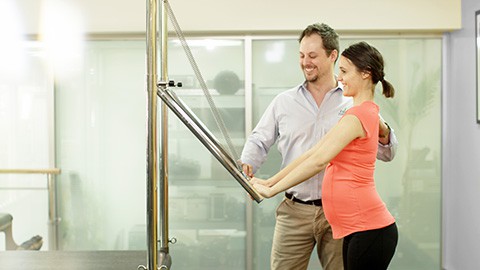What is it?
Diastasis recti, also known as abdominal separation, is the separation of your rectus abdominus (6-pack muscle) and widening or stretching of your linea alba. The linea alba is connective tissue which runs vertically down the center of your rectus abdominus. As the uterus expands during pregnancy, hormones released by the body help to relax the linea alba, allowing it to stretch further to make space for a growing baby. A physiotherapist can help you!

What causes it?
Abdominal separation is common for pregnant women, with 27% demonstrating this after their first trimester and approximately 2 in 3 demonstrating this in their third trimester. Almost 1 in 3 women will experience abdominal separation following delivery of their first child, and 2 in 3 following the delivery of their second or more children. During pregnancy, there are a number of factors which can lead to abdominal separation. These may include:
- Genetic predisposition
- Multiple pregnancies
- Weight gain during pregnancy
- Stretching of the muscles of the abdominal wall
- Hormonal changes
- Abdominal muscle weakness
- Repeated heavy lifting during pregnancy
How do I know if I have it?
The most intensive, spontaneous healing of abdominal separation occurs during the first 8 weeks postpartum. Following this period of time is a good time to begin to check for and/or monitor abdominal separation.
Diastasis recti is more accurately diagnosed with ultrasound to assess tissue changes with greater precision. Diagnosis and prognosis can also be made by a physiotherapist or through thorough palpation and examination of your abdominal region, with or without using ultrasound.
Self assessment is possible and easily completed by following the steps below:
- Laying on your back with your knees bent, use your fingers to press into your midline of the abdominal wall along your linea alba (divider of 6 pack muscles). Feel from the bottom of the sternum (breast bone) to the pubic bone (bony prominence ~3-4 inches below your belly button). Feel for differences in tension of the linea alba.
- Place 2 fingers across this midline so that the fingers are inline with the linea alba. Now, tuck your chin and lift your head (as if you are trying to look at your belly button) and you should feel the abdominal muscles active (not too forcefully). You should feel the sides of the abdominal muscle press into and put pressure on your fingers as you do this. If you do not feel any pressure with 2 fingers, try 3. Complete this at the level of your belly button, 2 and/or 4 fingers above and 2 and/0r 4 fingers below. Note how tight or taut the linea alba is and how much knuckles deep the fingers go into the linea alba.
- Complete step 2 while completing an exhaling breath through pursed lips, like blowing out a candle

What can I do about it?
If you do have or suspect you have diastasis recti, an assessment by a physiotherapist is recommended to determine the degree of abdominal separation and the most appropriate path to reduce this separation for you. Some things which may be used to achieve this include:
- Retraining our pelvic floor: these are the muscles which lay under and support the bowel, uterus and bladder. These muscles may be weakened during pregnancy and/or childbirth. A study by Zhang (et al. 2018) details dysfunction of the pelvic floor muscles following pregnancy occurring in approximately 83% of women who demonstrate diastasis rectiThe pelvic floor muscles and transverse abdominis muscles work together to reduce abdominal separation.
- Retraining the transverse abdominis: this muscle wraps around the lower part of your torso and when engaged will help with deep abdominal stabilization. Pre/post natal exercise will focus on this area and following abdominal separation resolution and adequate strength/control for this will then be an appropriate time to begin retraining your rectus abdominus (6-pack muscle)!
- Wearing support garments: postnatally, wearing tubigrip, compressive garments and compressive/recovery shorts can provide support to your lower abdominal area while your body while it recovers
- Correct/improving lifting techniques: re-training appropriate movement strategies is important when recovering from abdominal separation. Try not to lift anything heavier than your baby for the first 8 weeks postpartum.
- Avoid strenuous high impact or demanding core exercises: try to log roll out of bed and avoid strong core exercises such as sit ups or crunches until the abdominal separation has resolved to reduce strain on the 6 pack muscles.
If you have noticed or unsure about abdominal separation, we recommend seeking assessment and guidance from a physiotherapist. We advocate for pre/postnatal physiotherapy care through thorough abdominal examination including a real time ultrasound to review the function of your deep core muscles. Developing a healthy, well functional deep core can aid to treat and prevent abdominal separation during pregnancy.
This blog was written by Luke Mrowka (Physiotherapist), from our Campbelltown practice.
References
Qu, E. and Zhang, X. (2018), OP20.07: Study on the correlation between diastasis recti and pelvic floor dysfunction using ultrasound. Ultrasound Obstet Gynecol, 52: 126-127. https://doi.org/10.1002/uog.19581
